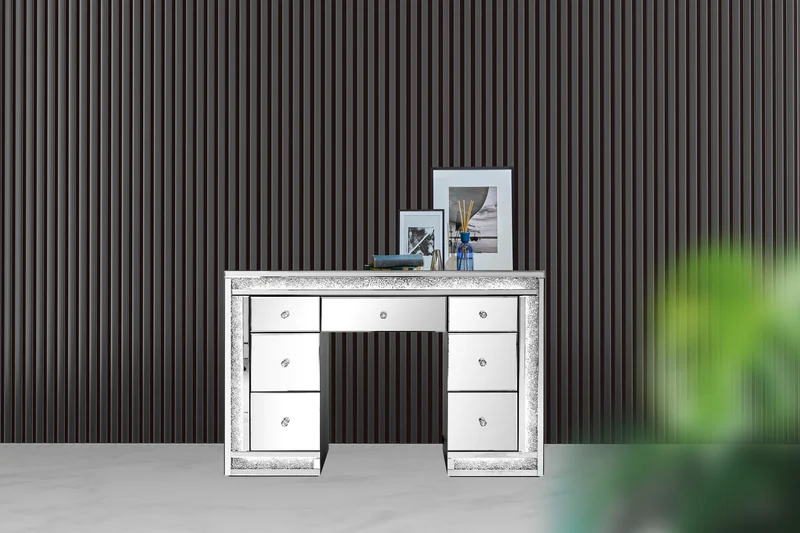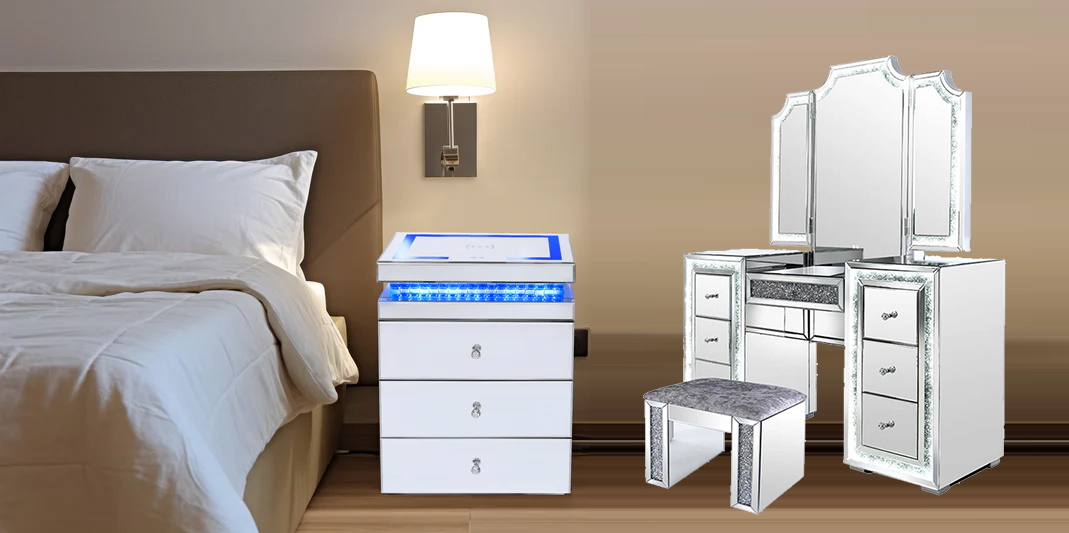Mirrored furniture can make any space feel more open and stylish by reflecting light. These pieces create an airy, elegant look. But choosing the right mirrored item means considering size, style, quality, and where to place it. This guide covers the basics of mirrored furniture - the different types, materials used, and how to evaluate quality. You'll get practical tips on measuring your space, setting a budget, and positioning mirrored pieces for the best look and functionality. By the end, you'll know how to pick mirrored furniture that maximizes your room while suiting your personal taste.
What Should You Know About Mirrored Furniture?
Mirrored furniture has been stylish for centuries, especially in grand European homes where it showed wealth and elegance. Today, these reflective pieces make any space feel bigger and brighter.
Different Types of Mirrored Furniture
Mirrored furniture comes in many forms - tables, dressers, cabinets, headboards, and more. Even functional items like chairs and shelves get a glamorous new look when covered in mirrored panels.

Pros of Mirrored Furniture
- Makes rooms appear larger and brighter
- Adds a stylish, elegant touch
- Versatile for many rooms
- Small accent pieces are easy to incorporate
Cons of Mirrored Furniture
- Shows smudges and dust more easily
- Not ideal for homes with young kids/pets
- Can look dated if not styled well
- Large pieces are very heavy to move
Now that you know the different types of mirrored furniture, and the key pros and cons, you can start visualizing how to incorporate these eye-catching pieces at home.
How to Choose the Right Design for Mirrored Furniture
1. Matching Your Style
Mirrored furniture comes in a variety of styles from vintage to modern. To ensure it complements your existing decor:
- For traditional spaces, look for ornate frames and curved lines
- In contemporary rooms, opt for clean frames and geometric shapes
- Pair mirrored pieces with similar wood tones or metal finishes
2. Finding the Right Size
Proper scale is crucial when adding mirrored furniture. An oversized piece can overwhelm a small space, while a tiny one may get lost in a grand room.
- Measure your room and the intended furniture location carefully
- Leave adequate space for foot traffic and opening doors
- Use vertical mirrored pieces like cabinets to maximize floor space
3. Functional Forms
Different shaped mirrored pieces serve different purposes:
- Rectangular or oval mirrors create depth perception
- Round accent tables are ideal for angled room corners
- Mirrored bureaus hide clutter behind closed doors
The shape you choose impacts both the aesthetics and functionality of the space. Consider your storage and focal point needs.
How to Assess Mirrored Furniture Materials and Quality
1. Examining the Materials
Mirrored furniture pieces use different materials for the mirror portions and frames:
Mirror Materials
- Plate glass mirrors provide the clearest reflection
- Antiqued mirrors have a distressed, vintage look
- Smoked or tinted mirrors add color and depth
Frame Materials
- Wood frames in finishes like cherry, oak, or painted styles
- Metal frames in chrome, gold, or brushed nickel finishes
- Composite frames made from resins or other man-made materials
2. Judging Build Quality
Look for solid wood frame construction and dovetail joints for maximum durability. Check that:
- Drawers glide smoothly on quality hardware
- Glass is securely adhered with mirror mastic
- There are no defects in glass like chips, bubbles or scratches
3. Caring for Mirrored Surfaces
Mirrored furniture needs proper care to stay sparkling:
- Use microfiber cloths or glass cleaners made for mirrors
- Avoid household cleaners with ammonia or acidic ingredients
- Immediately wipe up any spills or splatters
With knowledge about materials, construction quality, and care needs, you can better assess if a mirrored piece fits your requirements.

Where Should You Place Mirrored Furniture?
1. The Illusion of More Space
Strategically placing mirrored furniture can make any room feel more open and airy by reflecting light. Positioning pieces across from windows maximizes this effect.
2. Balancing the Space
In addition to making rooms feel larger, mirrored furniture helps create a balanced, well-designed layout when placed intentionally:
- Use a mirrored dresser or cabinet to anchor a bedroom
- Place a mirrored console or sideboard against an empty wall
- Position two mirrored side tables flanking a sofa or bed
3. Let There Be Light
Lighting is key to enhancing the reflective beauty of mirrored pieces. A few tips:
- Install lighting within cabinets/shelves to make contents glow
- Use overhead lighting and lamps to illuminate mirrored surfaces
- Angle furniture to catch and bounce natural light from windows
With clever positioning that maximizes light and spaciousness, your mirrored furniture will elevate your interior design to new levels of style and sophistication.
Practical Tips for Choosing Mirrored Furniture
1. Measure Twice, Buy Once
Properly measuring your space is crucial before purchasing mirrored furniture. A piece that looks perfect in the showroom could overwhelm your room.
- Measure the intended location's length, width and height
- Mark out dimensions on the floor with painter's tape
- Ensure adequate walkway and clearance for opening doors
2. Test for Sturdy Construction
Don't just admire the reflective surfaces - inspect the build quality too. At the store:
- Open drawers and cabinets to check mechanisms glide smoothly
- Lift and shake pieces to ensure they are solidly constructed
- Look underneath for quality joinery like wood dowels or dovetailing
3. Child and Pet Safety
Mirrored furniture has some safety considerations for homes with young kids or pets:
- Avoid pieces with sharp corners or protruding hardware
- Use mirror corner guards or edge bumpers
- Consider acrylic or shatterproof mirror alternatives
Taking the time to measure your space, assess construction, and prioritize safety will ensure your mirrored furniture investment looks amazing for years.

How Much Should You Budget for Mirrored Furniture?
Pricing Factors
The cost of mirrored furniture can vary greatly depending on several factors:
- Materials - Solid wood frames with glass mirrors are more expensive than composite materials.
- Size - Larger sized pieces command higher prices.
- Brand - Well-known, designer brands cost more than lesser-known makers.
- Customization - Having pieces made-to-order increases the price tag.
Quality vs Budget Balance
When setting your budget, decide which factors are highest priorities - quality construction or trendy styling. Focus spending on:
- Quality First - Invest in well-made, classic pieces that will last for years.
- Budget-Friendly - Look for more affordable options with composite frames/mirrors for trendy style.
With research on costs, prioritizing needs, and smart deal-hunting, you can obtain mirrored furniture that meets your style and budget requirements.
Elevate Your Space with Mirrored Furniture
Mirrored furniture can instantly uplift any room with its elegant, light-reflecting qualities. This guide provides insights to help you select and incorporate these stylish pieces based on your personal taste, room size, budget, and functional needs. From maximizing perceived space through strategic placement to ensuring quality construction, you'll learn how to harmonize beauty and practicality. Bring radiance and a touch of luxury to your interiors by investing in mirrored furniture that complements your unique style. Let these reflective pieces transform your home into a brilliant, one-of-a-kind haven.




Leave a comment
This site is protected by hCaptcha and the hCaptcha Privacy Policy and Terms of Service apply.